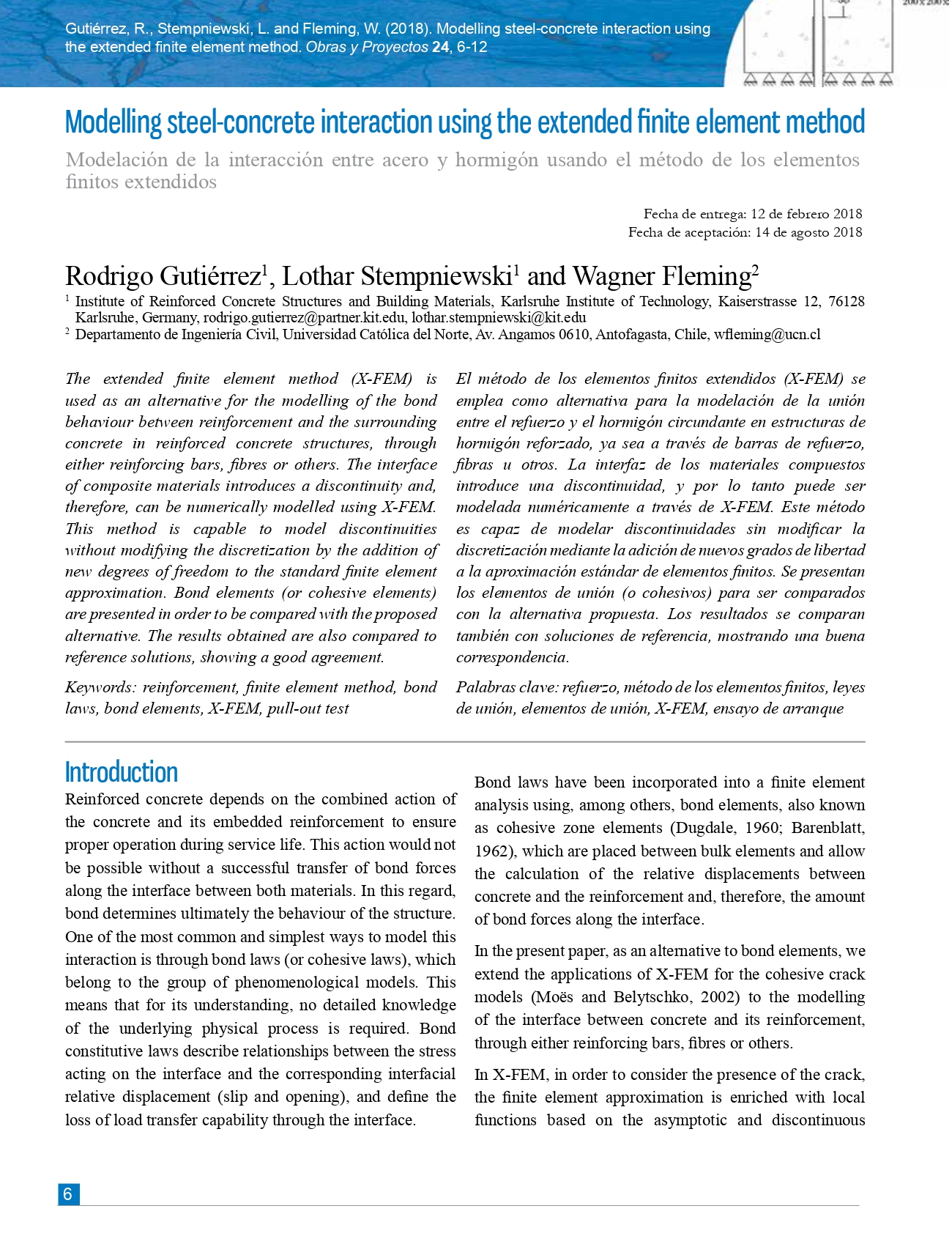Modelling steel-concrete interaction using the extended finite element method
DOI:
https://doi.org/10.4067/s0718-28132018000200006Keywords:
reinforcement, finite element method, bond laws, bond elements, X-FEM, pull-out testAbstract
The extended finite element method (X-FEM) is used as an alternative for the modelling of the bond behaviour between reinforcement and the surrounding concrete in reinforced concrete structures, through either reinforcing bars, fibres or others. The interface of composite materials introduces a discontinuity and, therefore, can be umerically modelled using X-FEM.This method is capable to model discontinuities without modifying the discretization by the addition of new degrees of freedom to the standard finite element approximation. Bond elements (or cohesive elements) are presented in order to be compared with the proposed alternative. The results obtained are also compared to reference solutions, showing a good agreement.
References
Barenblatt, G.I. (1962). The mathematical theory of equilibrium cracks in brittle fracture. Advances in Applied Mechanics 7, 55-129. https://doi.org/10.1016/S0065-2156(08)70121-2
Belytschko, T. and Black, T. (1999). Elastic crack growth in finite elements with minimal remeshing. International Journal for Numerical Methods in Engineering 45(5), 601-620. https://doi.org/10.1002/(SICI)1097-0207(19990620)45:5%3C601::AID-NME598%3E3.0.CO;2-S
Dolbow, J. (1999). An extended finite element method with discontinuous enrichment for applied mechanics. PhD thesis, Northwestern University, USA
Dugdale, D.S. (1960). Yielding of steel sheets containing slits. Journal of the Mechanics and Physics of Solids 8(2), 100-104. https://doi.org/10.1016/0022-5096(60)90013-2
Fédération Internationale du Béton (2012). Model Code 2010: Final draft. Switzerland: International Federation for Structural Concrete (fib): Lausanne.
Fleming, W. (2011). Quasi static and dynamic crack propagation in brittle materials with XFEM. PhD thesis, Universität Kassel, Germany
Lettow, S. (2011). Ein Verbundelement für nichtlineare Finite Elemente Analysen - Anwendung auf Übergreifungsstöβe. PhD thesis, Universitat Stuttgart, Germany
Möes, N. and Belytschko, T. (2002). Extended finite element method for cohesive crack growth. Engineering Fracture Mechanics 69(7), 813-833. https://doi.org/10.1016/S0013-7944(01)00128-X
Möes, N., Dolbow, J. and Belytschko, T. (1999). A finite element method for crack growth without remeshing. International Journal for Numerical Methods in Engineering 46(1), 131-150. https://doi.org/10.1002/(SICI)1097-0207(19990910)46:1%3C131::AID-NME726%3E3.0.CO;2-J
Radtke, F.K.F., Simone, A. and Sluys, L.J. (2010). A partition of unity finite element method for obtaining elastic properties of continua with embedded thin fibres. International Journal for Numerical Methods in Engineering 84(6), 708-732. https://doi.org/10.1002/nme.2916
van den Bosch, M., Schreurs, P. and Geers, M. (2006). An improved description of the exponential Xu and Needleman cohesive zone law for mixed-mode decohesion. Engineering Fracture Mechanics 73(9), 1220-1234. https://doi.org/10.1016/j.engfracmech.2005.12.006

Downloads
Published
Issue
Section
License
Copyright (c) 2018 Obras y Proyectos

This work is licensed under a Creative Commons Attribution-NonCommercial 4.0 International License.







